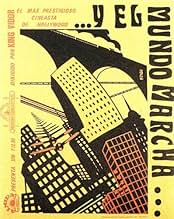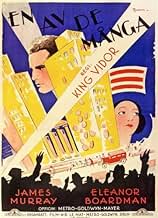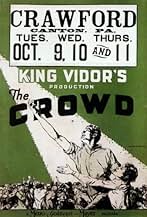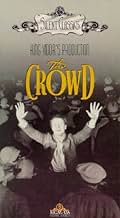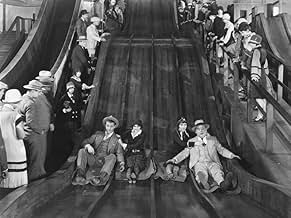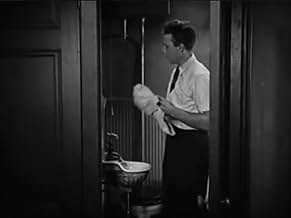NOTE IMDb
8,0/10
9,7 k
MA NOTE
La vie d'un homme et d'une femme ensemble dans une grande métropole impersonnelle à travers leurs espoirs, leurs luttes et leurs chutes.La vie d'un homme et d'une femme ensemble dans une grande métropole impersonnelle à travers leurs espoirs, leurs luttes et leurs chutes.La vie d'un homme et d'une femme ensemble dans une grande métropole impersonnelle à travers leurs espoirs, leurs luttes et leurs chutes.
- Réalisation
- Scénario
- Casting principal
- Nommé pour 2 Oscars
- 4 victoires et 2 nominations au total
John D. Bloss
- Boy on Fence
- (non crédité)
Roy Bloss
- Boy on Fence
- (non crédité)
Sidney Bracey
- John's Supervisor
- (non crédité)
Johnny Downs
- John - Age 12
- (non crédité)
Sally Eilers
- Party Girl at Bert's Place
- (non crédité)
Joseph W. Girard
- Member of Board of Directors
- (non crédité)
Pat Harmon
- Truck Driver
- (non crédité)
Chris-Pin Martin
- Worker in Hallway
- (non crédité)
Claude Payton
- Undetermined Secondary Role
- (non crédité)
Avis à la une
10lugonian
"THE CROWD" (Metro-Goldwyn-Mayer, 1928), directed by King Vidor, is a story about the average man, a born dreamer who promises but doesn't deliver, and his struggle to succeed and fight financial ruin. While top-billing goes to Vidor's wife, Eleanor Boardman, the movie belongs to an unknown named James Murray, who, in his debut performance as a movie actor, gives a remarkable performance as an ordinary American man with high ambitions.
The story about this common man begins on the 124th birthday of America, July 4th, 1900, in which a doctor delivers a baby boy to the Sims household. The baby boy is named John. The next scene finds John, now age 12, sitting on a wooden fence with his buddies, all discussing what they want to be when they grow up. John tells the other boys that he has big plans for his future, that he's going to be somebody really big. Suddenly a horse pulling ambulance stops in front of the Sims home. As Johnny rushes to see what's wrong, he is told by his mother that his father has died. Before the fade-out, this scene follows the boy with the shock-filled face walking alongside his mother up a long flight of stairs to be his father for the very last time. Years pass. Now John Sims (James Murray), age 21, has left his small town existence for a new life in New York City with great ambition to succeed. He later obtains an office job by day and goes to school at night. One evening, Bert (Bert Roach), John's co-worker and friend, persuades him to skip his studies and go on a double date with him and Jane (Estelle Clark). John is introduced to Jane's friend, Mary (Eleanor Boardman). John and Mary become acquainted, and after spending the fun evening in Coney Island, John proposes marriage to her as they return home by subway. Against the advise of her brothers (Daniel G. Tomlinson and Dell Henderson), Mary marries John. Over the years John and Mary become the parents of two children, a boy called Junior (Freddie Burke Frederick) and a girl (Alice Mildred Puter). While all seems to be going right for John, his marriage starts to fall apart as Mary gets fed up with John's constant promises he fails to keep, the loss of one of his children followed by the loss of his job, and depression leading John to a brink of suicide.
While MGM is best known for producing top-notch films headed by top-named stars, "The Crowd" features none of those elements. Instead of heading the cast with box office draws as John Gilbert and Norma Shearer, who could easily have played John and Mary, director Vidor uses his actress wife, Boardman, and an unknown he picked from the crowd named James Murray, supported by actors not known for anything more than minor character parts, such as Bert Roach, Lucy Beaumont as Mary's mother; and a crowd of street extras. What makes this movie so remarkable today is that the leading players are so real. John and Mary could be anybody watching this film. And the best of all, they aren't faked with glamour and sophistication that best expresses MGM movies. John and Mary are just ordinary people going about their ordinary lives. They love, quarrel and make up again. And whether "The Crowd" was actually filmed on location in New York City or not doesn't really matter. The feel of The Big Apple is there from the early sequence in which John observes New York City from the Hudson River ferry to the family having a picnic gathering on the beach on Coney Island; as well as the camera panning through the skyscrapers of the big city which leads to that now famous shot to the overhead view of a gigantic office with rows of desks and white-collar workers in their nine to five jobs.
The characters of John and Mary Sims were presented on film once again by King Vidor in an independent film titled "Our Daily Bread" (United Artists, 1934) starring Karen Morley and Tom Keene in the roles originated by Boardman and Murray. While Morley and Keene almost physically resemble their predecessors, what a treat it would have been if Boardman and Murray reprised their roles in the talkie sequel which depicts the Sims couple (sans children) struggling through the Depression by starting a farming community. By then, Boardman retired from acting and Murray was, like the character he played in "The Crowd," a man with ambition who fails to meet with success. Murray's reported drowning death in 1936 remains a mystery as to whether it was suicide or accidental. It's no wonder why Murray was so good in playing John Sims. He was really starring in his own life story, and didn't know it.
"The Crowd" was one of 13 MGM silent features that premiered on New York City's public television station of WNET, Channel 13, September 28, 1973, on MOVIES, GREAT MOVIES, hosted by Richard Schickel, with movie accompanied by an original score produced for this series. It was also one of the movies I recall watching every time it showed mainly because of an ordinary story that succeeds in holding my interest from start to finish. It's still a remarkable even today, ranking it one of the best silent movies ever produced. Out of circulation for more than a decade, "The Crowd" was distributed on video cassette in 1989 with a new Thames Orchestra score conducted by Carl Davis. At the running time of 104 minutes, "The Crowd" currently plays on Turner Classic Movies on a shorter length of 93 minutes. It's been mentioned by TV hosts, including Robert Osborne of TCM, that "The Crowd" was not an initial success, but thanks to frequent revivals in recent decades, it has been hailed, rightfully, as a cinematic masterpiece. (****)
The story about this common man begins on the 124th birthday of America, July 4th, 1900, in which a doctor delivers a baby boy to the Sims household. The baby boy is named John. The next scene finds John, now age 12, sitting on a wooden fence with his buddies, all discussing what they want to be when they grow up. John tells the other boys that he has big plans for his future, that he's going to be somebody really big. Suddenly a horse pulling ambulance stops in front of the Sims home. As Johnny rushes to see what's wrong, he is told by his mother that his father has died. Before the fade-out, this scene follows the boy with the shock-filled face walking alongside his mother up a long flight of stairs to be his father for the very last time. Years pass. Now John Sims (James Murray), age 21, has left his small town existence for a new life in New York City with great ambition to succeed. He later obtains an office job by day and goes to school at night. One evening, Bert (Bert Roach), John's co-worker and friend, persuades him to skip his studies and go on a double date with him and Jane (Estelle Clark). John is introduced to Jane's friend, Mary (Eleanor Boardman). John and Mary become acquainted, and after spending the fun evening in Coney Island, John proposes marriage to her as they return home by subway. Against the advise of her brothers (Daniel G. Tomlinson and Dell Henderson), Mary marries John. Over the years John and Mary become the parents of two children, a boy called Junior (Freddie Burke Frederick) and a girl (Alice Mildred Puter). While all seems to be going right for John, his marriage starts to fall apart as Mary gets fed up with John's constant promises he fails to keep, the loss of one of his children followed by the loss of his job, and depression leading John to a brink of suicide.
While MGM is best known for producing top-notch films headed by top-named stars, "The Crowd" features none of those elements. Instead of heading the cast with box office draws as John Gilbert and Norma Shearer, who could easily have played John and Mary, director Vidor uses his actress wife, Boardman, and an unknown he picked from the crowd named James Murray, supported by actors not known for anything more than minor character parts, such as Bert Roach, Lucy Beaumont as Mary's mother; and a crowd of street extras. What makes this movie so remarkable today is that the leading players are so real. John and Mary could be anybody watching this film. And the best of all, they aren't faked with glamour and sophistication that best expresses MGM movies. John and Mary are just ordinary people going about their ordinary lives. They love, quarrel and make up again. And whether "The Crowd" was actually filmed on location in New York City or not doesn't really matter. The feel of The Big Apple is there from the early sequence in which John observes New York City from the Hudson River ferry to the family having a picnic gathering on the beach on Coney Island; as well as the camera panning through the skyscrapers of the big city which leads to that now famous shot to the overhead view of a gigantic office with rows of desks and white-collar workers in their nine to five jobs.
The characters of John and Mary Sims were presented on film once again by King Vidor in an independent film titled "Our Daily Bread" (United Artists, 1934) starring Karen Morley and Tom Keene in the roles originated by Boardman and Murray. While Morley and Keene almost physically resemble their predecessors, what a treat it would have been if Boardman and Murray reprised their roles in the talkie sequel which depicts the Sims couple (sans children) struggling through the Depression by starting a farming community. By then, Boardman retired from acting and Murray was, like the character he played in "The Crowd," a man with ambition who fails to meet with success. Murray's reported drowning death in 1936 remains a mystery as to whether it was suicide or accidental. It's no wonder why Murray was so good in playing John Sims. He was really starring in his own life story, and didn't know it.
"The Crowd" was one of 13 MGM silent features that premiered on New York City's public television station of WNET, Channel 13, September 28, 1973, on MOVIES, GREAT MOVIES, hosted by Richard Schickel, with movie accompanied by an original score produced for this series. It was also one of the movies I recall watching every time it showed mainly because of an ordinary story that succeeds in holding my interest from start to finish. It's still a remarkable even today, ranking it one of the best silent movies ever produced. Out of circulation for more than a decade, "The Crowd" was distributed on video cassette in 1989 with a new Thames Orchestra score conducted by Carl Davis. At the running time of 104 minutes, "The Crowd" currently plays on Turner Classic Movies on a shorter length of 93 minutes. It's been mentioned by TV hosts, including Robert Osborne of TCM, that "The Crowd" was not an initial success, but thanks to frequent revivals in recent decades, it has been hailed, rightfully, as a cinematic masterpiece. (****)
Skilled technique and a thoughtful approach to the lives of some ordinary characters make "The Crowd" a memorable drama that tells an interesting, if mostly downbeat, story with some worthwhile observations on human relationships. It takes skill and judgment to make a memorable movie out of this type of material, and "The Crowd" is one of numerous quality pictures from the final years of the silent era that deserve to be much better remembered.
James Murray and Eleanor Boardman are completely believable as a typical couple starting out with all kinds of dreams and expectations. As they gain increasing experience in the real world, their reactions to events, especially on Murray's part, are by no means always appealing, but they are always genuine. The characters' flaws are made clear, yet you cannot help wishing for better things for them.
The story is structured carefully, with some interesting parallels between the early scenes and the closing sequences. With only a handful of really dramatic turns, the story reveals many things about the characters that implicitly comment on human nature in general. It does not offer many solutions, but it does provide some things to think about.
The symbolism of "The Crowd" fits well with the story, and it adds another dimension to this very effective drama. The occasional camera views of the office workers and other expansive settings re-emphasize the image in a resourceful and visually striking fashion.
James Murray and Eleanor Boardman are completely believable as a typical couple starting out with all kinds of dreams and expectations. As they gain increasing experience in the real world, their reactions to events, especially on Murray's part, are by no means always appealing, but they are always genuine. The characters' flaws are made clear, yet you cannot help wishing for better things for them.
The story is structured carefully, with some interesting parallels between the early scenes and the closing sequences. With only a handful of really dramatic turns, the story reveals many things about the characters that implicitly comment on human nature in general. It does not offer many solutions, but it does provide some things to think about.
The symbolism of "The Crowd" fits well with the story, and it adds another dimension to this very effective drama. The occasional camera views of the office workers and other expansive settings re-emphasize the image in a resourceful and visually striking fashion.
This has to be w/ out a doubt my favorite film of all time (althought Metropolis is a very close second). What King Vidor brought to the silver screen when he made this film was pure genius. Few films compare to this one. The Techniques used are way ahead of their time and reminiscent of few directors before him. Not even Griffith could obtain such amazing crowd footage as Vidor did. The story line is one that we can still relate to today, wanting to achieve our dreams but just falling short. Today it's called depression or something of the sort but then in an age of new development it was different. Not being able to achieve greatness wasn't uncommon but it felt that way. And the character in this film is no exception, I truly recommend this film to anyone who doesn't mind a good drama and to anyone who wants to see what life was like in the late 1920's.
The most remarkable thing about 'The Crowd (1928)' is that is manages to cover so much emotional ground. John (James Murray) is a young man who knew from an early age that he would become somebody special, that he would stand out from the crowd. At age 21, he travels to New York, the towering metropolis introduced via a montage of impressive high- angled shots that resemble Robert Florey's 'Skyscraper Symphony (1929).' John joins the accounting sector of a large insurance firm, and studiously assures himself that he need only work his way up. Years pass. John marries, has two children. It takes him five years to realise that he has become what he swore never to become: a member of The Crowd.
Vidor's message is a double-edged sword. Early in the film, The Crowd is something to be loathed: the camera, in a virtuoso display of technical brilliance, swoops down upon a seemingly-endless room of seated accountants, each man turning pages in mechanical unison. (Billy Wilder later paid homage to this scene in 'The Apartment (1960)'). But when John finally determines to break free from The Crowd, his world falls apart around him – he can't maintain a job, his wife threatens to leave him, he loses his dignity. The film's ending is intriguing in its ambiguity: John is absorbed into the crowds of a laughing theatre audience.
Is it a happy ending, an embracing of conformity? Is it ironic, an acknowledgment of mass delusion? Is Vidor integrating his character into the cinema audience? In 'The Bicycle Thief (1948),' a similar disappearance into the crowd is viewed as tragic, but here I'm not so sure. F.W. Murnau's 'The Last Laugh (1924)' told a similar tale, depicting the bleak prospects of a working-class doorman, played by Emil Jannings. UFA studio thwarted that film by enforcing a ludicrous happy ending that Murnau included only with a snide introductory title card. M-G-M also toyed with a happy ending to 'The Crowd,' but fortunately Vidor's version ultimately won out, a conclusion genuinely unsettling in its uncertainty, and sure to inspire discussion.
Vidor's message is a double-edged sword. Early in the film, The Crowd is something to be loathed: the camera, in a virtuoso display of technical brilliance, swoops down upon a seemingly-endless room of seated accountants, each man turning pages in mechanical unison. (Billy Wilder later paid homage to this scene in 'The Apartment (1960)'). But when John finally determines to break free from The Crowd, his world falls apart around him – he can't maintain a job, his wife threatens to leave him, he loses his dignity. The film's ending is intriguing in its ambiguity: John is absorbed into the crowds of a laughing theatre audience.
Is it a happy ending, an embracing of conformity? Is it ironic, an acknowledgment of mass delusion? Is Vidor integrating his character into the cinema audience? In 'The Bicycle Thief (1948),' a similar disappearance into the crowd is viewed as tragic, but here I'm not so sure. F.W. Murnau's 'The Last Laugh (1924)' told a similar tale, depicting the bleak prospects of a working-class doorman, played by Emil Jannings. UFA studio thwarted that film by enforcing a ludicrous happy ending that Murnau included only with a snide introductory title card. M-G-M also toyed with a happy ending to 'The Crowd,' but fortunately Vidor's version ultimately won out, a conclusion genuinely unsettling in its uncertainty, and sure to inspire discussion.
I recently watched this silent movie and I was amazed by its timelessness.
People work everyday on an eight-hour job and has dreams to make it "BIG". In that way, he could stand out of "The Crowd". Eighty years later and people still go through the same routine. Any working person can symphatize with John Sims.
In my humble opinion, the movie is a precursor of the neo-realist movies produced in Europe during the post-World War II era. The movie, in a way, also prophesied the worse: The Great Depression. John Sims, who symbolizes the common man, found it difficult landing a stable job after he quit his previous one.
A great movie, I hope this one must be watched by the viewers of today.
People work everyday on an eight-hour job and has dreams to make it "BIG". In that way, he could stand out of "The Crowd". Eighty years later and people still go through the same routine. Any working person can symphatize with John Sims.
In my humble opinion, the movie is a precursor of the neo-realist movies produced in Europe during the post-World War II era. The movie, in a way, also prophesied the worse: The Great Depression. John Sims, who symbolizes the common man, found it difficult landing a stable job after he quit his previous one.
A great movie, I hope this one must be watched by the viewers of today.
Le saviez-vous
- AnecdotesSeveral years after the film was made, alcoholism had taken its toll on lead actor James Murray, who was reduced to panhandling in the street. Ironically, one of the passers-by he solicited for money turned out to be King Vidor, who offered him a part in the film's semi-sequel, Notre pain quotidien (1934). Murray declined the offer, thinking it was only made out of pity. He died in 1936 at the age of 35 in a drowning incident. Vidor was sufficiently compelled to write his life story as an unrealized screenplay, which he called "The Actor".
- GaffesAfter John sprays himself with milk when opening the bottle, his clothes go from covered with milk to clean from one shot to the next.
- Citations
Title Card: The crowd laughs with you always... but it will cry with you for only a day.
- Versions alternativesThere is an Italian edition of this film on DVD, distributed by DNA srl, "LA FOLLA (1928) + LA GRANDE PARATA (1925)" (2 Films on a single DVD), re-edited with the contribution of film historian Riccardo Cusin. This version is also available for streaming on some platforms.
- ConnexionsEdited into Quand on est belle (1931)
Meilleurs choix
Connectez-vous pour évaluer et suivre la liste de favoris afin de recevoir des recommandations personnalisées
- How long is The Crowd?Alimenté par Alexa
Détails
- Date de sortie
- Pays d’origine
- Langue
- Aussi connu sous le nom de
- The Crowd
- Lieux de tournage
- Coney Island, Brooklyn, Ville de New York, New York, États-Unis(nighttime establishing exterior shots)
- Société de production
- Voir plus de crédits d'entreprise sur IMDbPro
- Durée1 heure 38 minutes
- Couleur
- Mixage
- Rapport de forme
- 1.33 : 1
Contribuer à cette page
Suggérer une modification ou ajouter du contenu manquant


